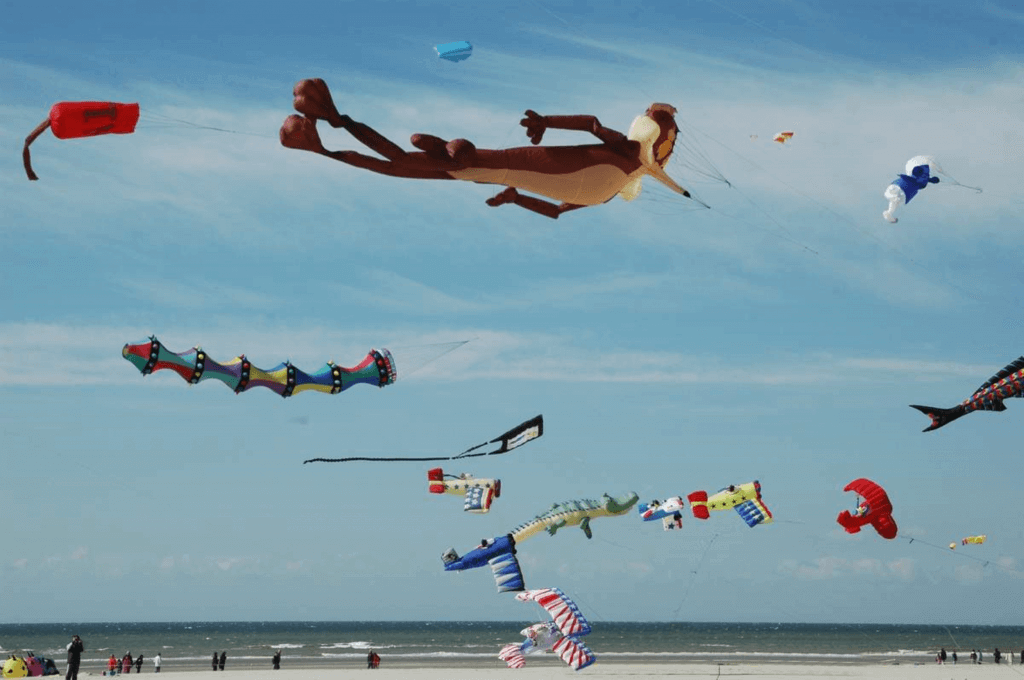Fly a Kite Day
(Also known as Go Fly a Kite Day)
Fly a Kite Day is observed next on Monday, June 15th, 2026 (157 days from today).

History of Fly a Kite Day
Fly a Kite Day took place on the anniversary of his birth in 1752 when Benjamin Franklin flew a kite during a thunderstorm; with the aim of demonstrating that lightning was caused by electrical discharges (some sources say that he flew a kite on October 10th). His experiments led to a deeper understanding of positive and negative charges, demonstrated that lightning was an electrical discharge, and the invention of the lightning rod that provided a safe way to discharge electricity and a prevent fire. Using lightning rod is a useful way to protect buildings, ships and people.
Franklin began his experiments with electricity in 1747 and began to hypothesize a connection between electricity and lightning two years later. He set out to prove his hypothesis; His idea was to build iron rods into storm clouds to draw electricity. He believes he will need to be aloft for his experiment to work, but he is in Philadelphia, a fairly flat city. At first, he was waiting for the steeple to be completed at Christ Church, believing he could use it for his experiments.
Franklin wrote about his iron rod idea to Peter Collinson, a member of the Royal Society of London, but the group didn't see the significance of the idea. Soon, however, his idea caught the attention of French scientists Delor and Dalibard. Shortly before Franklin did the experiment himself, unbeknownst to them, they had successfully completed his iron rod experiment, calling it the "Philadelphia experiment."
Franklin decided to test his theory by flying a kite instead of waiting for the steeple to be completed on the church. Together with his son William, he built a cedar kite and a silk handkerchief and attached a wire leg to its head to act as a conductor. At the bottom of the kite is a string, and at the point where the string is held is a strip of silk and a metal key. A metal wire connects to the key and goes to a Leyden jar.
When Franklin flew a kite during a lightning storm, he kept himself dry by standing in the barn. The kite is not hit, but the conductor carries a negative charge. They passed the kite, the string, the key, and reached the Leyden jar. This shows that a conductor can be used to conduct current to earth. At one point, he put his hand close to the key and was shocked because of the positive charge in his body. Franklin was later credited with coining many terms related to electricity.
Kites were used for centuries before Benjamin Franklin made his experiment. It is believed that the kites had originated from Shangdong, an eastern province of China and then spread to India Korea and then throughout Asia. There are a lot of different styles of kites as well as different cultural purposes for flying them; of course, they will appear in different locations. Early kites were usually made of bamboo, wrapped in silk and paper. In 1295 C.E., kites as well as how to fly were recorded by a European explorer named Marco Polo. By the sixteenth century, books and literature had publicized kites as children's toys, which made them popular.
Eventually, kites began to be used for science. In 1749, Scottish meteorologist Alexander Wilson had used a thermometer mounted on a kite in order to measure the air temperature at 3,000 feet. Three years later, Benjamin Franklin did his experiment to bring us Fly a Kite Day. The Wright brothers used kites for research when they were building their first airplanes in the late 1800s. During the first half of the twentieth century, new kite designs began to fly, such as the diamond kite, tetrahedral kite, flexible kite, ski kite and parafoil kite. Since the 1950s, NASA began using kites as the most useful way to recover spacecraft. Over the years, they were used for surveillance during war. The American Kite Players Association was founded in 1964. With so many uses, both for recreational and scientific purposes, kites are well-deserved today.
How to celebrate Fly a Kite Day
Both kite and Benjamin Franklin can be celebrated today. Perhaps the best way to celebrate is to fly a kite. If you don't have a kite, you can make your own. How about making a diamond kite or a tetrahedron kite? You can find some kite festivals or events in your area or plan and visit some of the other great kite festivals around the world. You can also join the American Association of Kite Players, find kite clubs and retailers in your area, or visit the World Kite Museum.
You can visit the tomb of Benjamin Franklin; your grave will be located at Christ Church Cemetery. While there, you can look up at the steeple that Franklin once waited to build before deciding to use a kite for his experiments. You can also visit the nearby Benjamin Franklin Museum.
It's probably best not to test Franklin's experiment at home, but his own description of what he did was published in the Pennsylvania Gazette on October 19th, 1752, and you can read it here:
"Make a Small Cross of two Light Cedar Bands, Arms reaching to the Four Corners of a large Thin Silk Handkerchief when stretched; tie the Corners of the Handkerchief to the Pole of the Cross, so you have a The body of a Kite; adapted to its Tail, Loop and String, would soar in the Air, like wings made of Paper; but this essence of Silk could withstand Wet Wind and Wind of Storms. Thunder without tearing The end of the Vertical Cross must be fixed with a String with a very sharp point, one Foot or higher than the Wood At the end of the Rope, followed by the Hand, tied with a Silk Ribbon, and where the Rope and silk connection, a Key can be fastened.This kite will be raised when Thunder appears and the Chain Holder must stand in a Door, or Window, or under some number. Cover, so that the Silk cannot get wet; and care must be taken that the Silk Thread does not touch the Frame of the Door or Window.As soon as any Thunderclouds have passed over the Kite, the Spike will absorb Fire electricity from them and the Kite, along with all the Strings, will be electrified, and the loose strands of the Rope will stand out in every way, and be attracted to an approaching Finger. And when the Rain wets the Kite and the Rope, so that it can conduct the Electric Fire freely, you will see it gushing abundantly from the Key on your Knuckle Approach. At this Key, Phial can get scaled; and from the resulting Electric Fire, Spirits may be created, and all other Electrical Experiments will be performed, usually performed by the Aid of an Orb or a Rubbed Glass Tube; and thus the similarity of Electrical Matter to the Matter of Lightning has been fully demonstrated."
Observed
Fly a Kite Day has been observed annually on June 15th.Dates
Saturday, June 15th, 2024
Sunday, June 15th, 2025
Monday, June 15th, 2026
Tuesday, June 15th, 2027
Thursday, June 15th, 2028


